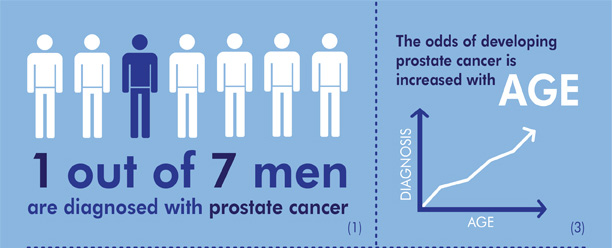About 70 percent of men diagnosed with prostate cancer through PSA screening have low-risk, low-grade disease. Unfortunately, over 90 percent of these men are placed under aggressive treatment soon after diagnosis when in real sense up to 60 percent of them may not need treatment, even in the long-term. Why does this happen? The common screening tests are not able to distinguish between men with prostate cancer that requires treatment and those with clinically insignificant disease. In fact, the PSA test, which is the most frequently used screening test, gives up to 12.5 percent false positive results.
Tackling overdiagnosis and overtreatment
There have been growing concerns over the increased number of prostate cancer cases diagnosed and treated following PSA testing. For instance, overdiagnosis through PSA tests has resulted in more men undergoing biopsy, which comes with adverse effects such as pain, acute urinary retention and urosepsis. Likewise, for men placed immediately under aggressive treatment, there are concerns over psychological distress and adverse effects to treatment such as urinary incontinence, bowel dysfunction and erectile dysfunction, among others, which are typically longstanding and life-altering. So because of the quality-of-life issues and financial costs, attention is shifting to ways of minimizing the harm caused by PSA screening, particularly ways of mitigating the conversion of overdiagnosis to overtreatment.
Risk-based screening
At Advanced Urology Institute, we have designed our screening, diagnosis and treatment processes for prostate cancer to respond to these growing concerns and minimize both overdiagnosis and overtreatment. For instance, we have included a candid patient-urologist discussion of both the PSA and digital rectal exam to make sure our patients are properly informed of their pros and cons. We also perform these screening tests in an individualized manner, based on each patient’s risk factors. As a baseline, we allow men to take their first PSA screening only when in their 40s. This enables us to develop the right screening protocol for each patient.
If a man’s PSA is low during the first test, we generally consider him to have a low lifetime risk of the disease and may not recommend frequent PSA measurements for him. And if we find PSA < 2 for a man in his 60s, we consider him to have a negligible chance of dying from the cancer and recommend that he not undergo any further PSA screening. It’s only for men with higher risk, such as those who have had a first-degree relative with the cancer — which doubles their risk of developing prostate cancer — that we may recommend more frequent screening.
Taking advantage of newer diagnostic tools
Previously, any man with a PSA result that was worrisome, such as one showing a rise over time or has an absolute high value, would automatically be a candidate for biopsy. At Advanced Urology Institute, we have changed this and now may perform other tests before we can recommend a biopsy. For instance, we can use a second test called PCA3 to define a man’s risk level and assess whether or not a biopsy is necessary for him. The PCA3 is a more specific marker for prostate cancer than the PSA and it can be measured in urine, usually after a DRE. Similarly, we can assess the aggressiveness of a tumor through genomic testing and use the results to determine whether immediate treatment or active surveillance is appropriate. So we use such tests to reduce the harm that our patients may suffer from biopsies done due to PSA-based overdiagnosis.
Individualized approach to treatment
To further reduce the chances of treating indolent prostate cancer, we use a combination of PSA and biopsy to assess and classify patients according to degree of aggressiveness of their disease. At AUI, we are committed to minimizing unnecessary, worthless or even harmful treatment after cancer diagnosis. Our most preferred management strategy, particularly for men diagnosed with localized, low-risk prostate cancer, is active surveillance as opposed to immediate treatment. It involves following men with low-grade, low-risk cancer closely and only providing treatment for tumors that exhibit aggressive behavior or are spreading to other areas of the body. Through careful observation, we have realized that a majority of men do not need treatment and therefore are spared the unnecessary aggressive interventions.
During active surveillance, we usually recommend serial PSA testing and biopsy to help monitor the behavior of the tumor. Before we put patients on active surveillance, we inform them that there is a possibility that the cancer may spread to keep them psychologically prepared just in case we detect progress. We also make them aware of the cancer-specific mortality with and without treatment, which is usually less than 10 percent without treatment and reduced by about 50 percent with radiation or surgery. We also inform them of the pros and cons of active surveillance and provide them with all the information they need to make personal treatment decisions.
Our approach is quite different for patients with high-risk prostate cancer. For them, we usually begin curative treatment as soon as possible, using the tools available to deliver safe, timely and effective treatment. The most common treatments for high-grade, high-risk prostate cancer are radiotherapy, high-intensity frequency ultrasound and robotic prostatectomy. Want to know more about prostate cancer screening, diagnosis and treatment? Visit the “Advanced Urology Institute” site.




 The prostate-specific antigen (PSA) test measures the amount of the protein (PSA) released in blood by prostate cells. Even though both normal and cancerous (abnormal) prostate cells produce the protein, higher blood levels of PSA indicate the possibility of cancer. The PSA test is one of the best indicators of prostate cancer and is recommended by urologists because it is widely available, relatively inexpensive and is a low-risk blood test for patients.
The prostate-specific antigen (PSA) test measures the amount of the protein (PSA) released in blood by prostate cells. Even though both normal and cancerous (abnormal) prostate cells produce the protein, higher blood levels of PSA indicate the possibility of cancer. The PSA test is one of the best indicators of prostate cancer and is recommended by urologists because it is widely available, relatively inexpensive and is a low-risk blood test for patients.



